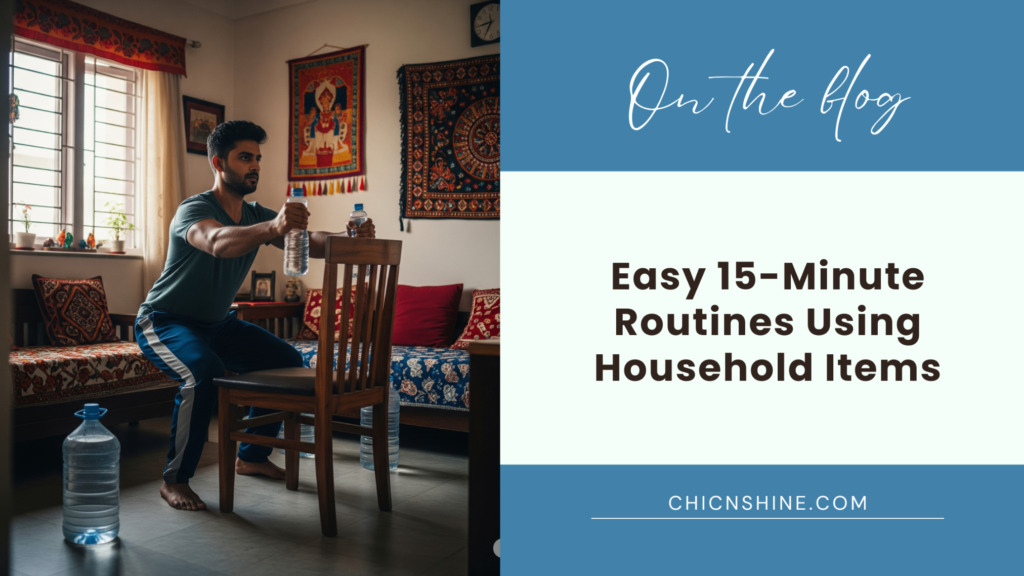Living in a cramped Mumbai apartment with barely enough space to stretch my arms, I never imagined I could create an effective no-gym home workout routine in India that would deliver results. However, after months of struggling with expensive gym memberships, crowded facilities, and the constant challenge of fitting workout schedules around my demanding job, I discovered that some of the most effective fitness routines could be performed right in my living room using nothing more than household items I already owned.
My transformation began during the 2020 lockdown when gyms were closed indefinitely, and I realized that waiting for external facilities to reopen was simply not an option. Through extensive research, trial, and error, and countless conversations with fitness enthusiasts on Reddit’s r/bodyweightfitness community, I developed a comprehensive system that has not only helped me maintain my fitness but actually improved my strength and endurance beyond what I achieved in traditional gyms.
Understanding the Indian Home Fitness Challenge
The reality of fitness in India presents unique challenges that most international workout guides simply don’t address. Our homes are typically smaller, we often share living spaces with multiple family members, and the concept of having a dedicated workout room is a luxury most of us cannot afford. Moreover, the extreme weather conditions in many parts of India make outdoor exercises impractical for several months of the year.
Through my experience developing this no-gym home workout routine in India, I’ve learned that the key to success lies not in having perfect conditions but in working creatively with what we have. Indian households are treasure troves of potential fitness equipment – from sturdy plastic chairs that can support our body weight to heavy water containers that serve as excellent weights for strength training.
Additionally, I’ve discovered through interactions on Quora’s fitness communities that many Indians struggle with the same fundamental issues I faced: lack of space, limited time, family interruptions, and the misconception that effective workouts require expensive equipment or gym memberships. These realizations helped me develop routines that address these specific challenges while delivering genuine results.
My Journey from Gym Dependency to Home Fitness Freedom
Two years ago, I was spending nearly ₹3000 per month on gym membership, plus additional costs for transportation and protein supplements. Despite this investment, I was struggling to maintain consistency due to Mumbai’s unpredictable traffic, long working hours, and the constant pressure of reaching the gym before it closed. Furthermore, I often felt intimidated by the gym environment and found myself rushing through workouts just to avoid peak hours.
The turning point came when I realized that my most effective workouts were happening at home during those desperate moments when I couldn’t make it to the gym. Those impromptu sessions using household items left me more energized and satisfied than my expensive gym routines. This revelation sparked my journey into developing a comprehensive no-gym home workout routine in India that could rival any professional fitness program.
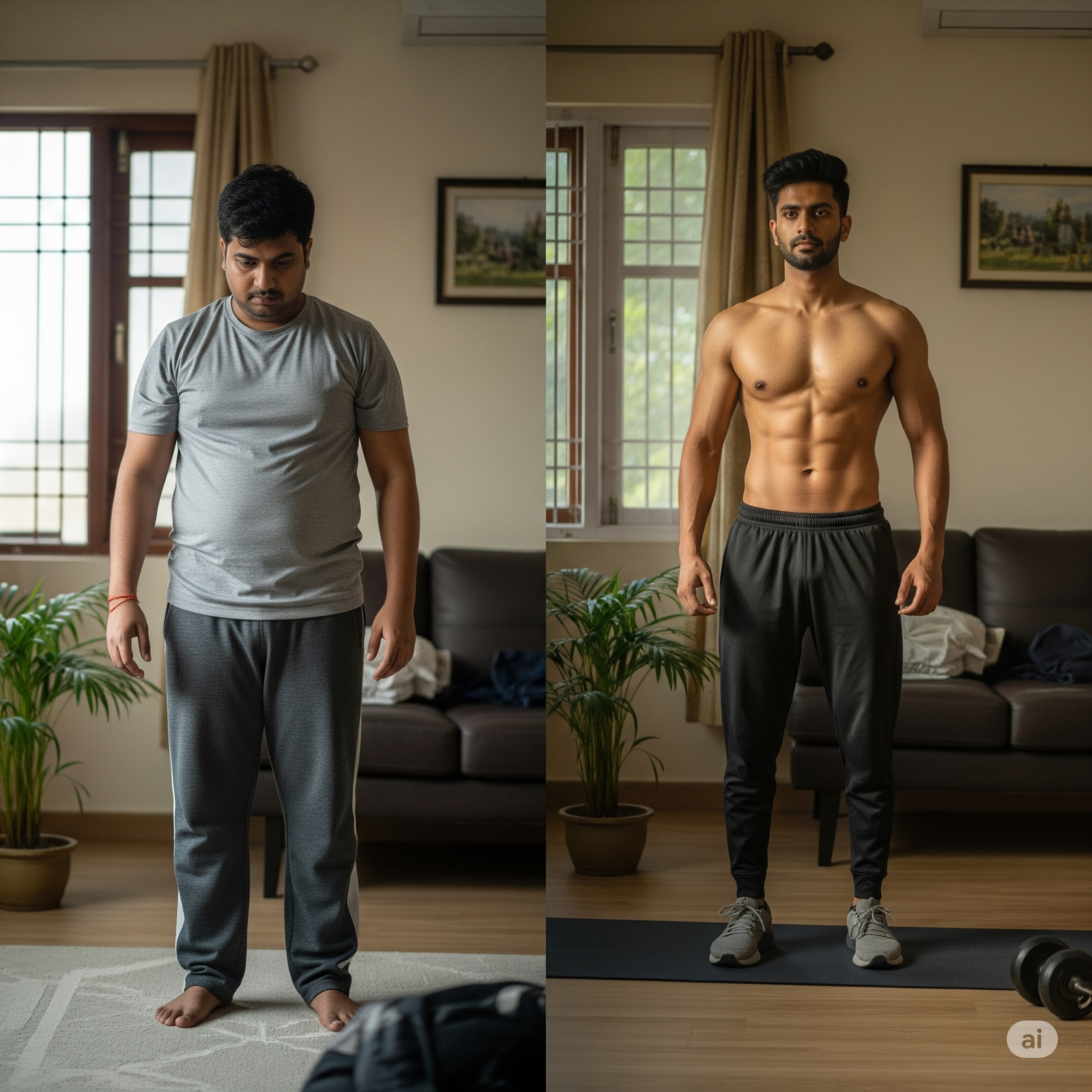
Through months of experimentation, I’ve developed routines that require nothing more than 15 minutes of your time and household items that every Indian home already contains. The results have been remarkable – I’ve not only maintained my fitness levels but improved my strength, flexibility, and overall health while saving thousands of rupees annually.
The Science Behind Household Item Workouts
What many people don’t realize is that resistance is resistance, regardless of whether it comes from expensive gym equipment or a sturdy plastic chair. The human body responds to progressive overload and consistent challenges, which can be achieved just as effectively with household items as with professional equipment. My research into exercise physiology, combined with insights from fitness professionals on various online platforms, has confirmed that bodyweight exercises combined with household items can provide comprehensive fitness benefits.
The key principle I’ve learned is that functional fitness – the kind that improves your daily life activities – is often better achieved through exercises that mimic real-world movements. Indian household items are perfect for this because they’re designed for daily use and can provide the varied resistance and stability challenges that our bodies need for complete fitness development.
Moreover, the psychological benefits of home workouts cannot be understated. Training in familiar surroundings eliminates the anxiety and self-consciousness that many people experience in gym environments. This comfort factor has significantly improved my consistency and enjoyment of exercise, leading to better long-term results.
Essential Household Items for Your Fitness Arsenal
Every Indian home contains a goldmine of fitness equipment disguised as everyday objects. Through my experimentation, I’ve identified several categories of household items that can form the foundation of any effective workout routine. Water bottles, whether plastic or glass, serve as excellent weights and can be adjusted for different resistance levels simply by changing the amount of water they contain.
Sturdy plastic chairs, which are common in most Indian households, become versatile pieces of equipment for everything from step-ups and tricep dips to incline push-ups and single-leg squats. The key is ensuring the chair can support your body weight safely – I always test this before incorporating any chair-based exercises into my routine.
Amazon Suggestion: [ non-slip yoga mat for floor exercises and better grip during home workouts ]
Additionally, I’ve found that heavy household items like large water containers, bags of rice or dal, and even heavy books can serve as excellent weights for strength training. The irregular shapes of these items provide additional stability challenges that can improve your functional strength more effectively than traditional dumbbells.
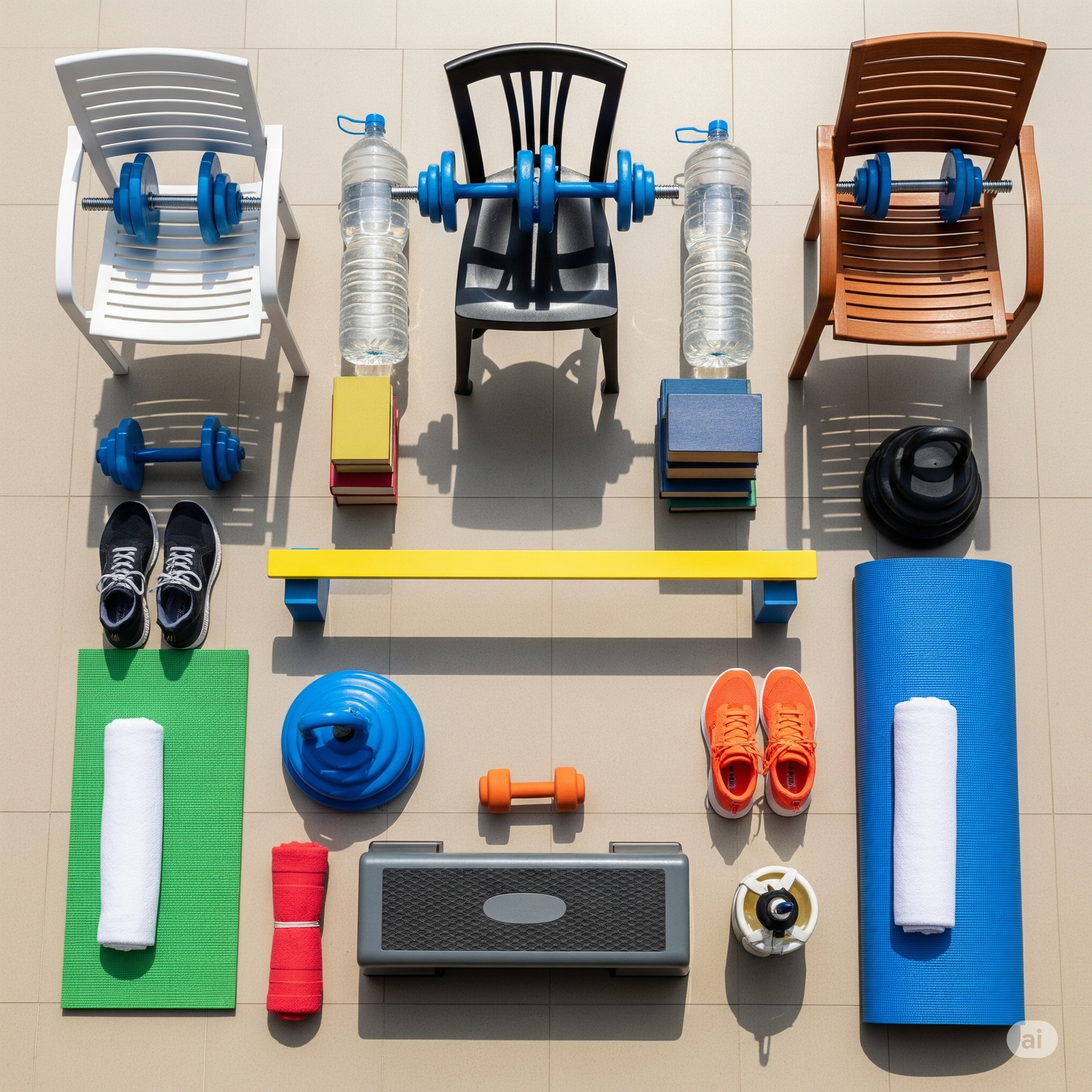
Towels, which every home has in abundance, become crucial for stretching, resistance exercises, and even cardio movements. The friction and flexibility of towels allow for unique exercise variations that target muscles in ways that traditional equipment cannot replicate.
The Complete 15-Minute Morning Routine
My morning routine has become the cornerstone of my daily fitness practice, and I’ve designed it to be completed within 15 minutes to ensure consistency even on the busiest days. This no-gym home workout routine in India begins with a dynamic warm-up using household stairs or simply marching in place while gradually increasing the intensity of arm movements.
The core of the routine involves a circuit that combines strength, cardio, and flexibility exercises using different household items. I start with chair-supported squats, which allow me to focus on proper form while building leg strength. Following this, I use water bottles as weights for overhead presses and bicep curls, adjusting the weight by changing the water levels based on my energy levels that particular day.
The beauty of this routine lies in its adaptability. On days when I have more energy, I increase the intensity by adding more repetitions or using heavier household items. When I’m feeling less energetic, I focus on controlled movements and longer holds, which still provide excellent benefits while respecting my body’s current state.
Push-ups using different household surfaces – from the floor to chair inclines – allow me to target different muscle groups and progress gradually. I’ve learned to use the edges of sturdy furniture for tricep dips, and heavy books or water containers for core exercises that challenge my stability and strength simultaneously.
Advanced Household Item Exercises for Experienced Practitioners
As my fitness level improved, I began incorporating more challenging exercises that utilized household items in creative ways. Single-leg deadlifts using heavy water containers not only build leg and glute strength but also improve balance and coordination. These functional movements have significantly improved my daily activities, from climbing stairs to carrying groceries.
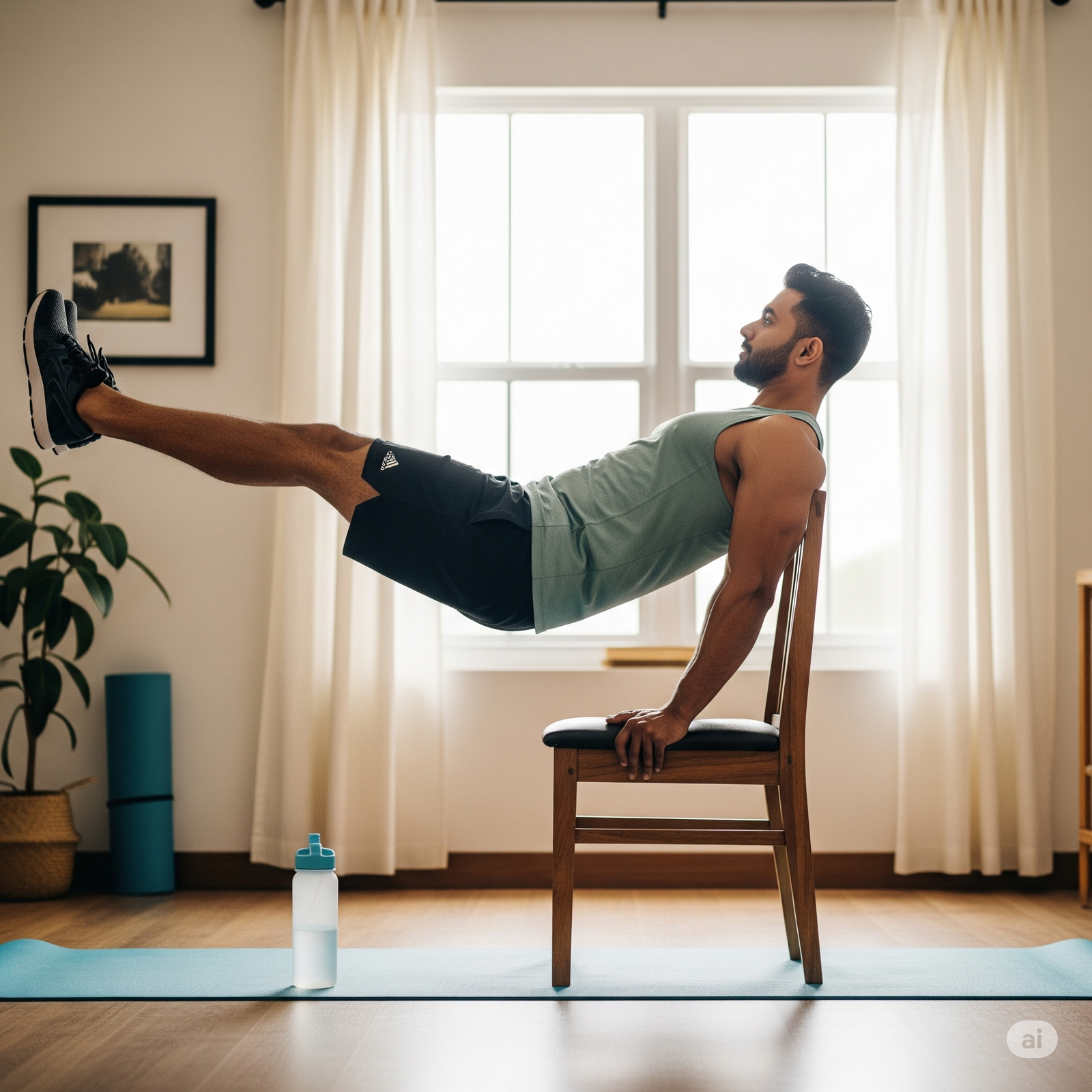
Towel exercises have become particularly valuable for developing grip strength and targeting muscles that traditional gym equipment often misses. Towel pull-apart, isometric holds, and resistance movements using towels have added a new dimension to my upper body training that I never experienced in traditional gym settings.
The progression principle remains crucial even with household items. I’ve learned to increase difficulty by adjusting angles, changing tempos, adding pauses, or combining movements into complex sequences. This approach ensures continuous challenge and improvement without requiring additional equipment or space.
Cardio Solutions for Small Indian Homes
Cardiovascular fitness presents unique challenges in small Indian homes, but I’ve discovered numerous solutions that provide excellent results without disturbing neighbors or family members. Stair climbing, when available, offers one of the most effective cardio workouts possible. Even a small flight of stairs can provide intense cardiovascular benefits when used creatively.
For homes without stairs, I’ve developed sequences that combine household item movements with bodyweight exercises to create high-intensity intervals. Using chairs for step-ups, water bottles for overhead movements, and floor space for mountain climbers creates a comprehensive cardio routine that rivals any gym equipment.
The key insight I’ve gained is that effective cardio is about elevating heart rate and maintaining intensity, not about specific equipment. By combining household items with bodyweight movements and focusing on minimal rest periods, I’ve created cardio routines that are both effective and sustainable for long-term practice.
Nutrition Integration for Home Fitness Success
My experience with a no-gym home workout routine in India has taught me that nutrition plays an equally important role as an exercise in achieving fitness goals. The convenience of home workouts allows for better integration of pre and post-workout nutrition, which has significantly improved my results and recovery times.
Working out at home means I can prepare fresh, healthy meals immediately after exercise, maximizing the anabolic window for muscle recovery and growth. I’ve developed simple nutrition strategies using common Indian ingredients that support my fitness goals while being practical for busy lifestyles.
Amazon Suggestion: [ high-quality protein powder suitable for Indian dietary preferences ]
The cost savings from avoiding gym memberships have allowed me to invest in better nutrition, which has created a positive cycle of improved health and fitness. This integration of exercise and nutrition at home has been one of the most significant factors in my successful transformation.
Overcoming Common Challenges and Obstacles
Throughout my journey, I’ve encountered and overcome numerous obstacles that are common to anyone attempting a no-gym home workout routine in India. Space limitations initially seemed insurmountable, but I learned to maximize vertical space and use furniture creatively to expand my workout area without permanently rearranging my living space.
Family distractions and interruptions were perhaps the biggest challenge I faced. However, I discovered that early morning workouts, before the household becomes active, provide the most consistent and peaceful exercise environment. Additionally, involving family members occasionally has turned some of my workouts into fun, bonding activities that everyone enjoys.

Motivation and consistency proved to be ongoing challenges that required creative solutions. I’ve found that tracking progress through photos, measurements, and performance improvements provides better motivation than traditional gym metrics. Additionally, connecting with online communities and sharing experiences has created accountability and support that rivals any gym environment.
Technology Integration for Enhanced Results
Modern technology has significantly enhanced my home workout experience, and I’ve learned to integrate various digital tools to maximize the effectiveness of my no-gym home workout routine in India. Fitness apps provide structured guidance, while online communities offer support and motivation that were previously only available through gym memberships.
Video tutorials and online fitness programs have allowed me to learn proper form and discover new exercises that I can adapt to my household items. The key is finding content that aligns with the reality of Indian homes and lifestyles rather than following routines designed for fully equipped gyms or large spaces.
Social media and fitness forums have become valuable resources for troubleshooting challenges, sharing experiences, and discovering new household item exercises. This virtual community has provided the support and motivation that traditional gym environments offer while being accessible 24/7 from the comfort of my home.
Long-term Sustainability and Progression
The most significant advantage of my no-gym home workout routine in India has been its sustainability over time. Unlike gym memberships that require ongoing financial commitments and travel time, home workouts using household items require no additional investment once established. This sustainability has allowed me to maintain consistency even during challenging periods of life.
Progression remains possible and necessary even with household items. I’ve learned to increase difficulty through various methods: adjusting resistance by adding water to bottles, changing angles and positions, increasing repetitions and sets, combining exercises into complex movements, and reducing rest periods between exercises. These progression techniques ensure continuous improvement without requiring new equipment.
The psychological benefits of mastering fitness independence cannot be overstated. Knowing that I can maintain and improve my fitness regardless of external circumstances has provided a sense of empowerment and confidence that extends beyond physical health into other areas of life.
Community Insights and User Experiences
Based on discussions from Reddit’s r/IndianFitness and various Quora fitness communities, I’ve discovered that my experiences with home workouts are shared by thousands of Indians who have successfully transitioned from gym dependency to home fitness independence. Common themes include the relief of avoiding gym politics, the satisfaction of creative problem-solving with household items, and the improved consistency that comes from eliminating travel and scheduling barriers.
Many users report that their home workout routines have become more intense and focused than their previous gym sessions. Without the distractions and social pressures of gym environments, they find themselves more in tune with their bodies and better able to push their limits safely and effectively.
Financial benefits consistently emerge as a major factor in user satisfaction. The money saved from gym memberships, travel costs, and expensive supplements has allowed many people to invest in better nutrition, occasional equipment upgrades, or other health and wellness initiatives that provide greater overall value.
Weather and Seasonal Adaptations
India’s diverse climate requires fitness routines that can adapt to extreme weather conditions, and home workouts provide the perfect solution to this challenge. During monsoon seasons when outdoor exercise becomes impossible, my household item routines ensure that fitness goals remain achievable and consistent.
Summer months, particularly in northern India, make outdoor exercise dangerous during peak hours. Home workouts allow for flexible scheduling that avoids the hottest parts of the day while maintaining air conditioning or fan cooling for comfort and safety.
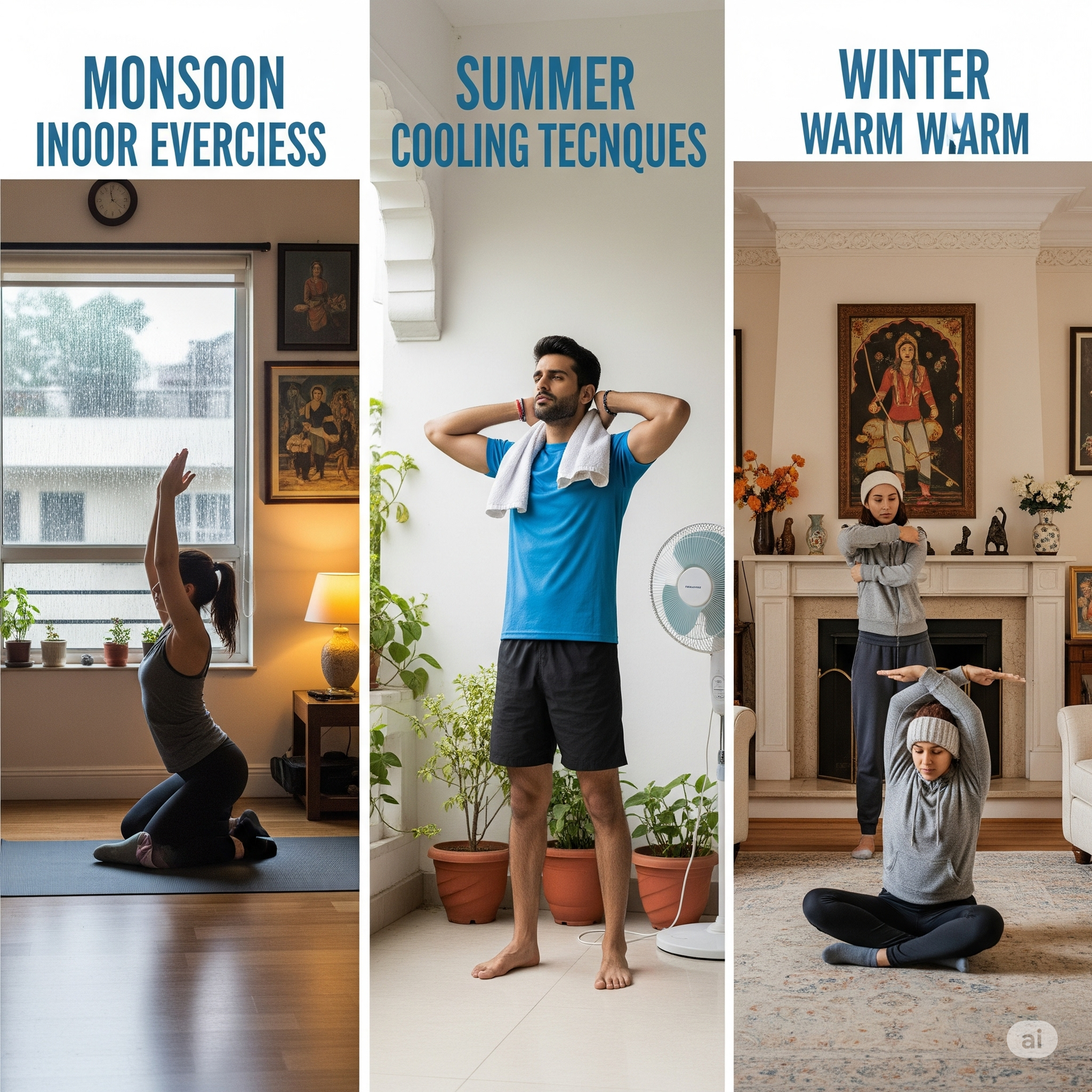
Winter months in many parts of India require different warm-up and preparation strategies. Home workouts allow for gradual warming in controlled environments, reducing injury risk and improving exercise enjoyment during colder periods.
Frequently Asked Questions
Can I build muscle using only household items for my no-gym home workout routine in India?
Absolutely! I've experienced significant muscle development using household items, and the science supports this completely. Muscle growth occurs when you provide progressive resistance and adequate recovery, which can be achieved with water bottles, chairs, and other household items. The key is consistency and gradually increasing the challenge. I've built more functional strength with household items than I ever achieved in traditional gyms because these exercises often engage stabilizing muscles that machines neglect.
How do I ensure I'm getting enough cardio without expensive equipment?
Cardiovascular fitness can be achieved excellently with household items and bodyweight exercises. I create high-intensity intervals using stairs, and chairs for step-ups, and combining movements like jumping jacks with household item exercises. The key is maintaining an elevated heart rate for sustained periods. Some of my most intense cardio sessions involve nothing more than household stairs and creative sequencing of movements.
What if I live in a small apartment with neighbors below - can I still do effective workouts?
This was one of my biggest concerns initially, but I've developed numerous low-impact routines that provide excellent results without disturbing neighbors. Chair exercises, wall push-ups, isometric holds, and controlled resistance movements using household items can be incredibly effective while remaining nearly silent. I focus on slow, controlled movements during early morning or late evening sessions, and I've never received complaints while achieving excellent fitness results.
How do I know if I'm progressing without gym equipment to measure my improvements?
Progress tracking at home is more comprehensive than gym measurements. I monitor improvements through increased repetitions, longer exercise durations, better form, improved daily activities, enhanced energy levels, and regular progress photos. I also track how many water bottles I can lift, how long I can hold positions, and how quickly I recover between exercises. These functional improvements often provide better indicators of real fitness progress than traditional gym metrics.
Conclusion
My journey from gym dependency to home fitness freedom using a no-gym home workout routine in India has been transformative in ways that extend far beyond physical health. The discovery that effective fitness requires creativity and consistency rather than expensive equipment has revolutionized not only my approach to health but also my understanding of what’s truly necessary for achieving personal goals.
The financial savings, time efficiency, and psychological benefits of home workouts using household items have created a sustainable lifestyle that I can maintain regardless of external circumstances. Whether facing lockdowns, financial constraints, weather challenges, or schedule pressures, my fitness routine remains consistent and effective.
Most importantly, this approach has taught me that the barriers to fitness are often more perceived than real. With creativity, consistency, and the willingness to see household items as fitness tools, anyone can achieve remarkable results from the comfort of their own home. The key is starting with what you have, staying consistent with your efforts, and gradually building both your fitness level and your collection of household item exercises.
Your fitness journey doesn’t require a gym membership, expensive equipment, or perfect conditions. It requires commitment, creativity, and the understanding that every Indian home already contains everything needed for comprehensive fitness development. Start today with a simple 15-minute routine using household items you already own, and discover the empowerment that comes from taking control of your health and fitness destiny.
